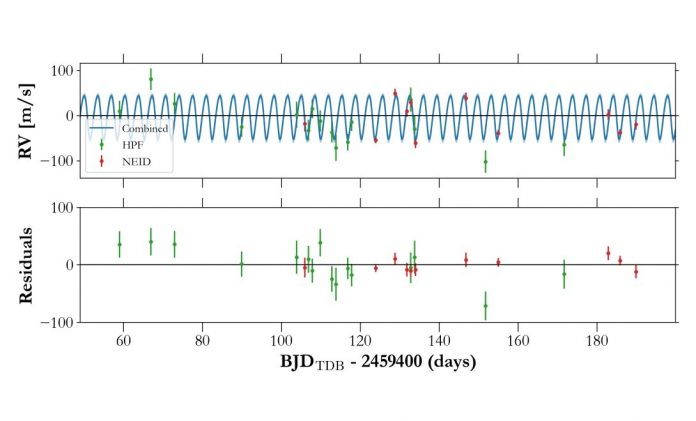Pennsylvania State University (PSU) astronomers detected a new Jupiter-sized extrasolar world. They have used NASA’s Transiting Exoplanet Survey Satellite (TESS). The new found exoplanet is designated as TOI-3757 b. It is slightly larger than Jupiter but more than three times less massive than the solar system’s biggest planet. The study is published in on arXiv.org.
TESS is conducting a survey of about 200,000 of the brightest stars near the sun. It has an aim of searching for transiting exoplanets. It has identified over 5,400 candidate exoplanets. Among these 199 have been confirmed so far.
A group of astronomers recently confirmed another TOI monitored by TESS. They report that a transit signal has been identified in the light curve of an M dwarf star known as TOI-3757. The planetary nature of this signal was confirmed by follow-up observations.
TOI-3757 b has a radius of about 1.09 Jupiter radii. Its mass is approximately 0.268 Jupiter masses. This yields a density of only 0.27 g/cm3. This makes it the lowest density planet orbiting an M dwarf known to date. The exoplanet orbits its host every 3.44 days. The equilibrium temperature of this planet is 759 K.
It is located around 578 light years away from the Earth. The parent star TOI-3757 is an M dwarf of spectral type M0V. It is about 37 percent smaller and less massive than the sun. The star has a solar metallicity. It is estimated to be 7.1 billion years old. TOI-3757 has the lowest stellar metallicity of all M dwarfs hosting gas giants.
Scientists tried to explain the low density of TOI-3757. They offer two most plausible hypotheses. They assume that the low metallicity of the M dwarf could be responsible for the delayed on-set of gaseous runaway accretion before the protoplanetary disk dissipated. It can also be a result of an evolution mechanisms where the tidal heating causes the inflation of the planet due to its slightly eccentric orbit.

